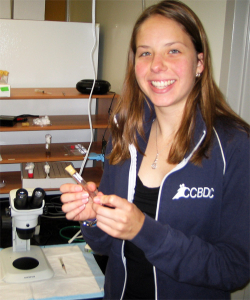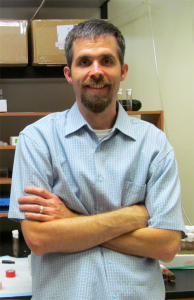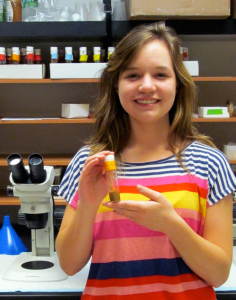 Studying the tiny jewel wasp – known in the scientific world as Nasonia vitripennis – may offer researchers important insights as they attempt to better understand certain chromosome-related diseases in humans such as cancer and some mental disorders.
Studying the tiny jewel wasp – known in the scientific world as Nasonia vitripennis – may offer researchers important insights as they attempt to better understand certain chromosome-related diseases in humans such as cancer and some mental disorders.
This groundbreaking work was the result of hours of rigorous study by Patrick Ferree, assistant professor of biology at the W.M. Keck Science Department, Scripps College alumna Megan Swim ’12 and Claremont McKenna College student Kelsey Kaeding ’15.
The Journal of Cell Science recently published their research, Impact of a Selfish B Chromosome on Chromatin Dynamics and Nuclear Organization in Nasonia.
“Our work highlights a very odd phenomenon, which is when certain parts of the genome – that is, all of the genes in a given organism – operate selfishly to survive at the harm of the rest of the genome,” says Ferree, Megan’s senior thesis advisor. “This condition is known as genome conflict. This is odd because normally the genome works together for survival.
“Our experiments are starting to reveal how selfish chromosomes can hijack the rest of the genome for enhanced transmission – which is what is happening at the cell and molecular levels in this wasp. It begs the question if this type of effect might occur in humans.”
 For Megan, this investigation allowed her to spend hours in a lab, studying embryos of the jewel wasp – an insect similar in size to an ant – under a microscope.
For Megan, this investigation allowed her to spend hours in a lab, studying embryos of the jewel wasp – an insect similar in size to an ant – under a microscope.
“Between being a teaching assistant and my thesis, I spent upwards of 40 hours a week doing some form of lab work,” says Megan, who based her senior thesis on this scientific project.
“Paternal Sex Ratio was the main focus of my study. PSR is an extra chromosome, known as a B chromosome, found in Nasonia vitripennis – the wasp,” explains Megan, who is now pursuing a master’s degree in biomedical science at the University of Edinburgh in Scotland. “While this B chromosome is only in Nasonia, there are thousands of B chromosomes in nature. Understanding more about this specific B chromosome can help with investigations into B chromosomes in other plants and animals.”
Her work on this project convinced her to continue graduate work in science.
“The phenomenon of this extra chromosome causing the destruction of the paternal set of chromosomes, and therefore, altering the sex of the resulting offspring is what drew me to this study,” Megan says.
This research can help scientists better understand human diseases such as certain cancers and mental disorders, Ferree says.
 “The PSR chromosome is made up entirely of ‘junk’ DNA – sequences that do not code for proteins – and some human diseases are also linked to such DNA. There is now good reason to believe that these sequences are at the root of the effect PSR has on the wasp genome,” Ferree says. “We need good models in animals like the wasp in order to do experiments that may end up telling us something about how such human diseases work.”
“The PSR chromosome is made up entirely of ‘junk’ DNA – sequences that do not code for proteins – and some human diseases are also linked to such DNA. There is now good reason to believe that these sequences are at the root of the effect PSR has on the wasp genome,” Ferree says. “We need good models in animals like the wasp in order to do experiments that may end up telling us something about how such human diseases work.”
Kelsey, who is now a sophomore majoring in molecular biology, worked on the study for four months during her first year at CMC.
“Research is a time-consuming process and it takes a lot of work, but it can be extremely rewarding. Investigating something that has never been studied before is exciting,” Kelsey says.
The trio used jewel wasp because the insect can be easily stored in a refrigerator. Also, the transparency of their embryos made visualization under the intensified lens of a microscope ideal for imaging, Megan says.
“This project is only the beginning and my work left more questions than it answered, but such is science,” Megan says. “This means the research will continue and these findings can only propel the study forward.”

